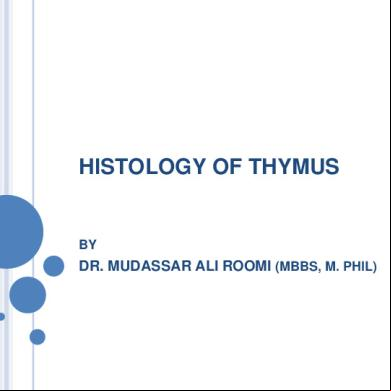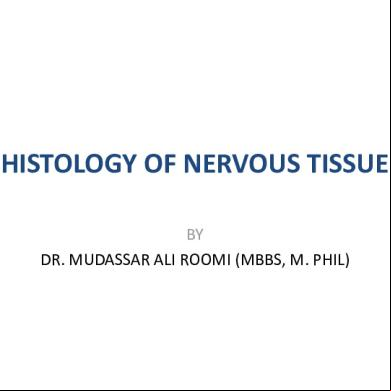6. Lecture On The Histology Of Peripheral Nerve And Ganglia By Dr. Roomi 3q4x5z
This document was ed by and they confirmed that they have the permission to share it. If you are author or own the copyright of this book, please report to us by using this report form. Report l4457
Overview 6h3y3j
& View 6. Lecture On The Histology Of Peripheral Nerve And Ganglia By Dr. Roomi as PDF for free.
More details h6z72
- Words: 532
- Pages: 15
HISTOLOGY OF NERVOUS TISSUE BY DR. MUDASSAR ALI ROOMI (MBBS, M. PHIL)
peripheral nerve • Peripheral nerves include: cranial nerves, spinal nerves. • It is made up of bundle of nerve fibers, both myelinated and unmyelinated. • On naked eye examination, it appears whitish and glistening because of their myelin and collagen content. • Examples: median nerve, ulnar nerve, sciatic nerve
peripheral nerve (cont.) • Epineurium: it is sheath of dense irregular C.T. around peripheral nerve. • Perineuriun: – it is C.T sheath around each fascicle or bundle of nerve fibers. – This is made by many concentric layers of epitheloid cells ed together by tight junctions . – Perineurium acts as a barrier to the age of materials.
• endoneurium: it is thin layer of C.T. around each nerve fiber. It is composed of delicate collagenous and reticular fibers and fibroblasts.
peripheral nerve (l.s.)
How to draw it!
peripheral nerve- identification points • Bundles of nerve fibers • Myelin sheath is seen as unstained area • Endoneurium, perineurium and epineurium is visible
GANGLIA
• Ganglia: It is collection of nerve cell bodies outside the CNS • Ganglia are ovoid structures associated with peripheral nerve. • microsopically and functionally the ganglia are of two types: – Craniospinal (sensory) ganglia – Autonomic ganglia
• Common features of both types of ganglia: – Both types of ganglia have C.T. capsule. – The body of each ganglion cell is surrounded by satellite cells
Cranio Spinal ganglia • • • •
Cranial ganglia Spinal ganlia (dorsal root ganglia) C.T. Capsule Ganglion cells are pseudounipolar neurons *** – Each cell has a single process which bifurcates in a T-shaped manner. – One of the two processes acts as dendrite and es to periphery to terminate at a receptor organ – The othe branch acts as axon and es to CNS.
• The nerve impulses from the periphery to CNS, bying the cell body. • So the cell body form no synapses and performs an exclusively trophic function.
Cranio Spinal ganglia (cont.) • The nerve cell bodies are arranged as groups in the peripheral zone of the ganglion. • Each ganglion cell is surrounded by a single layer of low cuboidal cells are called as satellite cells • Central zone of the sensory ganglion shows great predominance of nerve fibers
Dorsal root ganglion
dorsal root ganglion- identification points • Connective tissue capsule present • Pseudounipolar neurons surrounded by satellite cells
Dorsal root ganglion- how to draw it!
Autonomic Ganglia • These ganglia are associated with sympathetic and parasympathetic ANS. • These ganglia contain multipolar neurons: – Each ganglion cell has many dendrites and a single axon. – Dendrites receive synapses from the incoming preganglionic nerve fibers – Axon es out as postganglionic fiber.
Ganglia Cranio Spinal Cranial nerve ganglia
Autonomic Spinal ganglia
Cranio Spinal ganglia • ganlionic cells are present as groups in the ganglion. •Variable size of the ganglion cells •Pseudo – unipolar cells • Sensory • No synapse • +++ satellite cells • complete capsule of satellite cells
Sympathetic
Parasympathetic
Autonomic ganglia •Evenly distributed • •Uniform size • Multipolar cells • Secretomotor • ++ synapse • + satellite cells • incomplete capsule of satellite cells
peripheral nerve • Peripheral nerves include: cranial nerves, spinal nerves. • It is made up of bundle of nerve fibers, both myelinated and unmyelinated. • On naked eye examination, it appears whitish and glistening because of their myelin and collagen content. • Examples: median nerve, ulnar nerve, sciatic nerve
peripheral nerve (cont.) • Epineurium: it is sheath of dense irregular C.T. around peripheral nerve. • Perineuriun: – it is C.T sheath around each fascicle or bundle of nerve fibers. – This is made by many concentric layers of epitheloid cells ed together by tight junctions . – Perineurium acts as a barrier to the age of materials.
• endoneurium: it is thin layer of C.T. around each nerve fiber. It is composed of delicate collagenous and reticular fibers and fibroblasts.
peripheral nerve (l.s.)
How to draw it!
peripheral nerve- identification points • Bundles of nerve fibers • Myelin sheath is seen as unstained area • Endoneurium, perineurium and epineurium is visible
GANGLIA
• Ganglia: It is collection of nerve cell bodies outside the CNS • Ganglia are ovoid structures associated with peripheral nerve. • microsopically and functionally the ganglia are of two types: – Craniospinal (sensory) ganglia – Autonomic ganglia
• Common features of both types of ganglia: – Both types of ganglia have C.T. capsule. – The body of each ganglion cell is surrounded by satellite cells
Cranio Spinal ganglia • • • •
Cranial ganglia Spinal ganlia (dorsal root ganglia) C.T. Capsule Ganglion cells are pseudounipolar neurons *** – Each cell has a single process which bifurcates in a T-shaped manner. – One of the two processes acts as dendrite and es to periphery to terminate at a receptor organ – The othe branch acts as axon and es to CNS.
• The nerve impulses from the periphery to CNS, bying the cell body. • So the cell body form no synapses and performs an exclusively trophic function.
Cranio Spinal ganglia (cont.) • The nerve cell bodies are arranged as groups in the peripheral zone of the ganglion. • Each ganglion cell is surrounded by a single layer of low cuboidal cells are called as satellite cells • Central zone of the sensory ganglion shows great predominance of nerve fibers
Dorsal root ganglion
dorsal root ganglion- identification points • Connective tissue capsule present • Pseudounipolar neurons surrounded by satellite cells
Dorsal root ganglion- how to draw it!
Autonomic Ganglia • These ganglia are associated with sympathetic and parasympathetic ANS. • These ganglia contain multipolar neurons: – Each ganglion cell has many dendrites and a single axon. – Dendrites receive synapses from the incoming preganglionic nerve fibers – Axon es out as postganglionic fiber.
Ganglia Cranio Spinal Cranial nerve ganglia
Autonomic Spinal ganglia
Cranio Spinal ganglia • ganlionic cells are present as groups in the ganglion. •Variable size of the ganglion cells •Pseudo – unipolar cells • Sensory • No synapse • +++ satellite cells • complete capsule of satellite cells
Sympathetic
Parasympathetic
Autonomic ganglia •Evenly distributed • •Uniform size • Multipolar cells • Secretomotor • ++ synapse • + satellite cells • incomplete capsule of satellite cells









